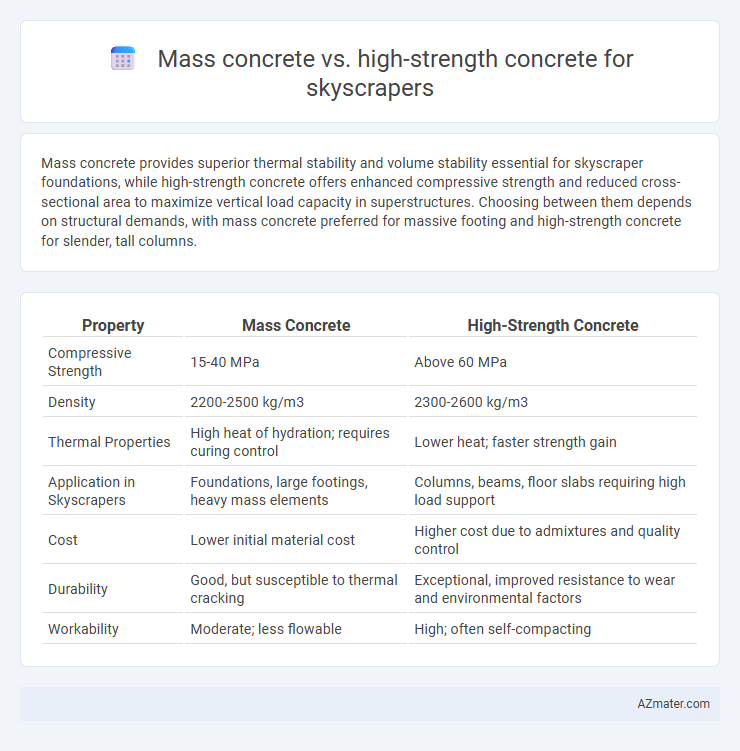Mass concrete provides superior thermal stability and volume stability essential for skyscraper foundations, while high-strength concrete offers enhanced compressive strength and reduced cross-sectional area to maximize vertical load capacity in superstructures. Choosing between them depends on structural demands, with mass concrete preferred for massive footing and high-strength concrete for slender, tall columns.
Table of Comparison
| Property | Mass Concrete | High-Strength Concrete |
|---|---|---|
| Compressive Strength | 15-40 MPa | Above 60 MPa |
| Density | 2200-2500 kg/m3 | 2300-2600 kg/m3 |
| Thermal Properties | High heat of hydration; requires curing control | Lower heat; faster strength gain |
| Application in Skyscrapers | Foundations, large footings, heavy mass elements | Columns, beams, floor slabs requiring high load support |
| Cost | Lower initial material cost | Higher cost due to admixtures and quality control |
| Durability | Good, but susceptible to thermal cracking | Exceptional, improved resistance to wear and environmental factors |
| Workability | Moderate; less flowable | High; often self-compacting |
Overview of Mass Concrete and High-Strength Concrete
Mass concrete is characterized by its large volume and low heat of hydration, making it essential for the foundational and structural components of skyscrapers to control thermal cracking and ensure stability. High-strength concrete, defined by compressive strengths above 6000 psi, offers superior load-bearing capacity and durability, enabling the design of slender columns and longer spans in high-rise buildings. Both types are integral to skyscraper construction, with mass concrete providing foundational integrity and high-strength concrete optimizing structural efficiency and height.
Key Characteristics of Mass Concrete
Mass concrete used in skyscrapers is characterized by its large volume and low heat of hydration, which minimizes thermal cracking during curing. Its formulation typically includes low cement content and supplementary cementitious materials to reduce heat generation and improve durability. Unlike high-strength concrete, mass concrete prioritizes thermal stability and volume control over compressive strength, making it essential for massive structural elements like foundations and retaining walls.
Defining Features of High-Strength Concrete
High-strength concrete for skyscrapers is characterized by its compressive strength exceeding 6,000 psi (approximately 41 MPa), achieved through a low water-to-cement ratio and advanced admixtures like silica fume and superplasticizers. This concrete type offers enhanced durability, reduced permeability, and higher elasticity modulus compared to mass concrete, enabling slender structural elements and efficient load transfer. The optimized microstructure of high-strength concrete improves resistance to environmental degradation and supports the vertical expansion demands of modern skyscraper design.
Structural Requirements in Skyscraper Construction
Mass concrete in skyscraper construction provides excellent thermal stability and load distribution due to its substantial volume and moderate strength, making it ideal for foundational elements and core supports. High-strength concrete offers superior compressive strength and reduced cross-sectional area, enabling slimmer structural components and increased usable floor space in skyscrapers. Structural requirements often dictate a combination of both materials to balance durability, load-bearing capacity, and design flexibility in tall building frameworks.
Comparative Strength and Durability
Mass concrete offers exceptional compressive strength and thermal stability, making it ideal for foundational elements in skyscrapers where load distribution and durability against environmental stresses are crucial. High-strength concrete provides superior tensile strength and enhanced durability, allowing for thinner structural components and greater height potential while resisting corrosion and chemical attack. The choice between mass concrete and high-strength concrete depends on balancing load-bearing requirements with structural design goals and long-term durability in high-rise construction.
Thermal Performance and Heat Generation
Mass concrete in skyscrapers exhibits slower heat dissipation due to its larger volume and lower cement content, reducing the risk of thermal cracking during curing but potentially causing elevated core temperatures. High-strength concrete, with a denser microstructure and higher cement content, generates more heat during hydration, increasing thermal gradients and demanding advanced cooling techniques to maintain structural integrity. Optimizing the balance between heat generation and dissipation is critical for skyscraper safety and durability, influencing selection based on thermal performance requirements.
Mix Design and Material Composition
Mass concrete for skyscrapers typically features a low cement content with a focus on thermal control, using coarse aggregates and water-to-cement ratios around 0.4 to 0.6 to manage heat of hydration. High-strength concrete incorporates higher cementitious materials including silica fume and superplasticizers, reducing water-to-cement ratios below 0.35 to achieve compressive strengths above 70 MPa while maintaining workability. The mix design of mass concrete prioritizes volume stability and heat dissipation, whereas high-strength concrete emphasizes durability, density, and load-bearing capacity for slender structural elements.
Application Suitability in Tall Buildings
Mass concrete is ideal for skyscraper foundations and cores due to its excellent thermal stability, minimizing the risk of cracks from heat generated during curing. High-strength concrete suits the structural framework and load-bearing columns, providing greater compressive strength and reducing cross-sectional dimensions for efficient space usage. Selecting the appropriate concrete type enhances both durability and structural integrity in tall building construction.
Cost Implications and Economic Considerations
Mass concrete for skyscrapers offers lower initial material costs due to the use of conventional aggregates and cement but requires extensive labor and time for curing, increasing overall project duration and expense. High-strength concrete, though more expensive per cubic meter because of premium materials like silica fume and chemical admixtures, reduces structural volume and allows slimmer designs, potentially lowering formwork and foundation costs. Economic considerations must balance upfront material expenses against lifecycle savings from reduced floor-to-floor heights, faster construction cycles, and long-term durability benefits associated with high-strength concrete.
Future Trends in Concrete Technology for Skylines
Mass concrete offers excellent thermal stability and load distribution for skyscraper foundations, while high-strength concrete provides superior compressive strength essential for slender, taller superstructures. Future trends focus on integrating ultra-high-performance concrete blends and nanomaterial additives to enhance durability, reduce carbon footprint, and enable innovative architectural designs. Advanced mix designs and real-time monitoring systems are set to revolutionize concrete performance, ensuring sustainability and resilience in evolving urban skylines.

Infographic: Mass concrete vs High-strength concrete for Skyscraper
 azmater.com
azmater.com